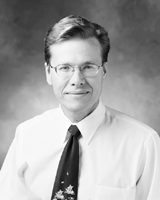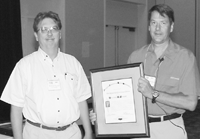Combined Annual Meeting/Control Conference Draw 950 to San Diego
September 10, 2001

With the launch of NASA's Genesis Discovery Mission just a few weeks away, Jerrold Marsden's joint invited talk was ideally timed. The launch date (which turned out to be August 8) would be "an exciting day for dynamical systems," he said; computation of the mission trajectory had to do with "real celestial mechanics," taking into account "all the major bodies in the solar system." The problem was discussed in several other sessions in San Diego as well; it is, Marsden concluded, "a very nice mixture of dynamical systems (providing guidance and first guesses) and optimal control."
Highlights for all were two joint invited talks---"Dynamical Systems and Control in Celestial Mechanics and Space Mission Design," by Jerrold Marsden of Caltech, and "Pervasive Wireless Networks: Some System Theoretic Challenges," by P.R. Kumar of the University of Illinois, Urbana-Champaign.
Attendees at both meetings enjoyed Steven Strogatz's I.E. Block Community Lecture, on small-world networks, and Thomas Hou's James H. Wilkinson Prize lecture, "Multi-scale Computation and Modeling of Flows in Strongly Heterogeneous Porous Media." And Gilbert Strang thoughtfully tailored his Past President's Address to the setting by working the Kalman filter into his discussion of tridiagonal matrices.
Both meetings were the occasion for the recognition of good work, at many levels. One of SIAM's oldest and most prestigious prizes, The John von Neumann Lecture, was given this year by David Donoho of Stanford University (and is briefly described here with the assistance of Gilbert Strang). Much newer---awarded in San Diego for only the second time---is the Ralph E. Kleinman Prize; a short description of the work for which the prize committee selected William Symes of Rice University also appears here.
Two prizes recognized exceptional work in control and systems theory: the W.T. and Idalia Reid Prize in Mathematics, awarded to Eduardo Sontag of Rutgers University (see SIAM News, July/August 2001), and the SIAM Activity Group on Control and Systems Theory Prize, to Vincent Blondel of l'Universit� Catholique de Louvain.
Further coverage of the other prizes and of topics covered at both meetings will appear in upcoming issues of SIAM News.
*****
The John von Neumann Lecture, given annually, is one of SIAM's highest honors. Very few guidelines are offered to the lecturer, who is simply asked to "survey and evaluate a significant and useful contribution to mathematics and its applications."
David Donoho of Stanford University clearly satisfied the requirements with his title---"What Lies Beyond Wavelets? Explorations in Multiscale Thinking"---and he certainly went far beyond wavelets in his lecture. But he did much more, working von Neumann into the lecture at almost every step. The long ago (1959) creators of SIAM's John von Neumann Lecture could hardly have envisioned a better model for the tradition they were establishing.

John von Neumann Lecturer David Donoho.
Donoho's lecture illustrated an astonishing unity of knowledge in the sciences (an idea that was central to von Neumann's thinking, especially toward the end of his life). One striking fact mentioned by Donoho shows how far mathematics still has to go to represent images with anything close to the efficiency of the human visual system. Our eyes and brain accept input at 107 bits per second. That input is highly redundant, and a lot of it seems useless. At the end of processing, we actually acquire information at a rate closer to 20-40 bits per second. That compression ratio, enormous by any standard, is certainly far beyond anything that Fourier or wavelet representations could achieve.
A signal processed by JPEG generally loses fidelity and breaks up at a compression ratio of 30 to 1. Images have edges, and these discontinuities destroy a Fourier series. This is the Gibbs phenomenon, one of the greatest barriers to fast and accurate computation. Wavelets---because they are localized and multiscale---do much better in one dimension. Donoho's first goal (and a central problem in image processing) is to deal with edges in higher dimensions, where---except when the edge is horizontal or vertical---wavelets are definitely not the best choice.
Multiscale thinking by Donoho and his student Emmanuel Cand�s (who received this year's Popov Prize, as reported in the July/August issue of SIAM News) gave a first answer for the case of edges that are straight. In place of wavelets, which have poor directional properties, Donoho and Cand�s created ridgelets. A ridgelet is localized in the direction normal to the edge (it depends on x . n)---it is a "plane wavelet." If the edge is curved, though, ridgelets are too restricted. The Cand�s-Donoho construction of "curvelets" works from short pieces of ridgelets to follow the curved edge.
Along with the mathematics, Donoho provided an overwhelming flow of connections to other disciplines. One was the statistics of natural images. (Donoho is in the statistics department at Stanford, and statistics, in fact, was more strongly represented in San Diego than at any other SIAM annual meeting.) The really big step here is to mammalian vision, where Hubel and Wiesel conjectured how a light stimulus might be processed in the cortex. Could we approximate that process by filters (convolutions) in parallel? What is the architecture of sensory processing systems?
Donoho suggested an ideal (mathematical) architecture for an edge-dominated world: a multiscale pyramid, with many directions and positions at each length scale (and needle-shaped elements at fine scales!). Perhaps we will live long enough to learn whether the design of our brain is anything like this model. Whether the answer is yes or no, E.O. Wilson's idea of "consilience," a modern version of von Neumann's unity, was at the heart of Donoho's lecture.
*****
William Symes of Rice University received the Ralph E. Kleinman Prize at the San Diego meeting. Established in 1998 in memory of long-time University of Delaware faculty member Ralph Kleinman, the prize recognizes "outstanding research, or other contributions, that bridge the gap between mathematics and applications."
Symes, the Noah Harding Professor in the Department of Computational and Applied Mathematics at Rice, was cited "for his work on seismic inverse problems, in particular his creation of the mathematical and computational framework for a method known as Differential Semblance Optimization."

Honored for his work in seismic inverse problems, William Symes (left) received the Ralph E. Kleinman Prize from SIAM president Tom Manteuffel.
Symes is without doubt among the best and most accomplished mathematicians working in the area of seismic inverse problems, says Fadil Santosa of the University of Minnesota. Before Symes's work on the concept of differential semblance optimization, Santosa explains, geophysicists relied on ad hoc methods to estimate the material properties of earth from seismic data; these methods often depend on human subjectivity, and in some cases are based on conflicting principles. "There was a need to make the process robust and automatic." The concept of differential semblance optimization, developed during a ten-year period by Symes, with students and postdocs, is based on a separation of scales in the parameters, and the relation between the parameters at the different scales and the data. Using such tools as microlocal analysis and Fourier integral operators, the group systematically attacked theoretical aspects of the problem, Santosa explains. Also addressed, in great depth, were computational and optimization issues, along with software design questions.
Among the recent contributions of Symes and colleagues is the Hilbert Class Library, an object-oriented approach to abstract nonlinear least-squares that, according to Santosa, "has received rave reviews from the user community." Symes is unique, Santosa says, in that his contributions to his field have "encompassed mathematical analysis, numerics, and software engineering."
As far as the applications aspect of the prize, several oil companies use methods based on differential semblance optimization, and, Santosa concludes, "Symes is highly respected in the geophysics community, where his work in inverse problems and numerical methods for the wave equation are well known."
The Ralph E. Kleinman Prize recognizes work that uses high-level mathematics and/or invents new mathematical tools to solve applied problems from engineering, science, and technology. The prize committee bases its selection on both the quality of a nominee's mathematics and its impact on the application. Symes is the second recipient of the prize; Robert Kohn of the Courant Institute received the prize in 1999, at the SIAM Annual Meeting in Atlanta. The prize, which consists of a certificate and a cash award of $5000, is to be awarded every other year.
*****
On hand to present their papers from the Mathematical Contest in Modeling were members of the two teams named SIAM winners. The winning teams were from Wake Forest University (Adam Dickey, Corey Houmand, and Andrew Pruett, and faculty adviser Miaohua Jiang) and the U.S. Military Academy (Matthew Adams, Nicholas Howard, and Zachariah Miller, and faculty adviser Major Donovan D. Phillips). Other students honored for their work, also described in presentations at the meeting, were the three recipients of the SIAM Student Paper Prize: Matthew I. Smith of the University of Manchester, Rog�rio Martins of the University of Lisbon, and Mason Porter of Cornell University.
Also honored at the meeting were this year's recipients of the SIAM Outstanding Paper Prize, given annually to the authors of exceptionally original papers published in SIAM journals during the three preceding years: Tom�s A. Arias, Alan Edelman, and Steven T. Smith, Massachusetts Institute of Technology, "The Geometry of Algorithms with Orthogonality Constraints," SIAM Journal on Matrix Analysis and Applications, 20(2) 1999, 303-353; Michele Benzi, Scientific Computing Group, Los Alamos National Laboratory, and Miroslav Tuma, Institute of Computer Science, Academy of Sciences of the Czech Republic, "A Sparse Approximate Inverse Preconditioner for Nonsymmetric Linear Systems," SIAM Journal on Scientific Computing, 19(3) 1998, 968-994; and Pedro Morin and Ricardo H. Nochetto, University of Maryland, College Park, and Kunibert G. Siebert, Universit�t Freiburg, "Data Oscillation and Convergence of Adaptive FEM," SIAM Journal on Numerical Analysis, 38(2) 2000, 466-488.

